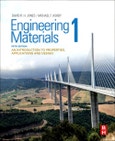Widely adopted around the world, Engineering Materials 1 is a core materials science and engineering text for third- and fourth-year undergraduate students; it provides a broad introduction to the mechanical and environmental properties of materials used in a wide range of engineering applications. The text is deliberately concise, with each chapter designed to cover the content of one lecture. As in previous editions, chapters are arranged in groups dealing with particular classes of properties, each group covering property definitions, measurement, underlying principles, and materials selection techniques. Every group concludes with a chapter of case studies that demonstrate practical engineering problems involving materials. The 5th edition boasts expanded properties coverage, new case studies, more exercises and examples, and all-around improved pedagogy.
Engineering Materials 1, Fifth Edition is perfect as a stand-alone text for a one-semester course in engineering materials or a first text with its companion Engineering Materials 2: An Introduction to Microstructures and Processing, in a two-semester course or sequence.
Table of Contents
1. Engineering Materials and Their Properties
Part A: Price and Availability 2. Price and Availability of Materials
Part B: Elastice Moduli 3. Elastic Moduli 4. Bonding between Atoms 5. Packing of Atoms in Solids 6. Physical Basis of Young's Modulus 7. Applications of Elastic Deformation 8. Case Studies in Modulus-Limited Design
Part C: Yield Strength, Tensile Strength, and Ductility 9. Yield Strength, Tensile Strength, and Ductility 10. Dislocations and Yielding in Crystals 11. Strengthening and Plasticity of Polycrystals 12. Continuum Aspects of Plastic Flow 13. Case Studies in Yield-Limited Design
Part D: Fast Fracture, Brittle Fracture, and Toughness 14. Fast Fracture and Toughness 15. Micromechanisms of Fast Fracture 16. Fracture Probability of Brittle Materials 17. Case Studies in Fracture
Part E: Fatigue Failure 18. Fatigue Failure 19. Fatigue Design 20. Case Studies in Fatigue Failure
Part F: Creep Deformation and Fracture 21. Creep Deformation and Fracture 22. Kinetic Theory of Diffusion 23. Mechanisms of Creep, and Creep-Resistant Materials 24. The Turbine Blade-A Case Study in Creep-Limited Design
Part G: Oxidation and Corrosion 25. Oxidation of Materials 26. Case Studies in Dry Oxidation 27. Wet Corrosion of Materials 28. Case Studies in Wet Corrosion
Part H: Friction and Wear 29. Friction and Wear 30. Case Studies in Friction and Wear
Part I: Thermal Properties 31. Thermal Expansion 32. Thermal Conductivity and Specific Heat 33. Final Case Study:Materials and Energy in Car Design
Appendix








